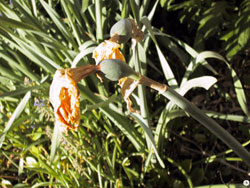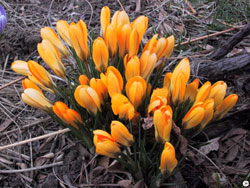Gardeners dutifully buy and plant more and more Dutch bulbs every autumn. In wet climates, many of these bulbs would rot in humid summer conditions. But in our sunny, dry climate, bulbs often return and even naturalize, forming dense clumps of color from a single plant. Groupings of naturalized bulbs can be divided, much like many other perennials.
 To ensure that bulbs will flower year after year, try to site them in an optimum microclimate. Daffodils tolerate shade and like lots of moisture. However, crocuses, tulips and alliums like lots of sun and heat. Like any perennial, bulbs grow best in amended soils. Avoid sites with extreme sun exposure, dryness or traffic.
To ensure that bulbs will flower year after year, try to site them in an optimum microclimate. Daffodils tolerate shade and like lots of moisture. However, crocuses, tulips and alliums like lots of sun and heat. Like any perennial, bulbs grow best in amended soils. Avoid sites with extreme sun exposure, dryness or traffic.

If your bulbs don’t bloom prolifically after a couple of years, they may need more nutrition. Add compost or commercial dry-bulb fertilizers when the bulbs are dormant. Or give the leaves a light feeding with half-strength fertilizer such as Jack’s Classic Blossom Booster after flowering is done, but before the foliage begins to turn brown.
Bulbs must reach sufficient size to produce flowers. When bulbs grow too close together, overgrown clumps produce dense, narrow foliage and very sparse bloom. These bulbs are good candidates for division. The best time to dig bulbs is in midsummer when they are dormant. Once bulbs have been divided, they should be planted in fresh soil.
Seasoned gardeners have discovered that most bulbs do quite well if moved right after blooming instead of waiting until mid-summer. Some miniature bulbs, such as reticulated irises and snowdrops, will bloom with no transplant shock the spring following division, provided gardeners don’t keep them out of the ground too long. Daffodils and tulips are nearly as forgiving.
Transplanting “in the green,” as this procedure is called, is the best way to avoid slicing dormant bulbs or leaving bulbs behind. Just a year or two after division, your planting will look like new.
For more information, see the following Colorado State University Extension fact sheet(s).



